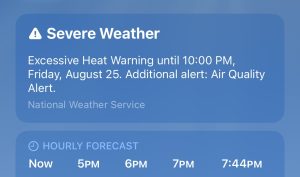A dangerous wave of heat and humidity has made its way across the bi-state area this week with temperatures ranging from 95 to 100+ degrees each afternoon. Heat index values have topped 117, which marks the fourth highest heat index value ever recorded in the region. As a result, the National Weather Service has issued an excessive heat warning for the St. Louis metropolitan area through the end of the week, and likewise, an air quality alert has been in effect since Sunday.
Area residents may have noticed these alerts appearing on their phone’s weather app every day this week due to the air quality index (AQI) exceeding values of 100. This new feature became available at the start of the air quality forecasting season to inform individuals about the quality of the air they’re breathing and the risks they face.
“All dissemination services at our disposal receive these air quality alerts,” said Kevin Deitsch, Warning Coordination Meteorologist for the National Weather Service of St. Louis. “That was the idea behind us getting involved since we have the ability to get the word out through multiple channels when the air quality reaches unhealthy levels, and we’re happy to hop on board to keep the public informed. Other weather apps will pull all of our information as well, whether it’s the iPhone app, Weather Channel app, or the local TV station’s weather apps, so it’s effective to provide the added visibility.”
Using data generated by the Clean Air Partnership’s daily air quality forecasts, the National Weather Service of St. Louis issues the alerts on forecasted orange or red days, which means that maximum ozone concentration is expected to reach levels that pose a serious risk for adverse health effects. High concentrations of ground-level ozone can cause shortness of breath, coughing, wheezing, headaches, nausea, and eye and throat irritation. Even in healthy adults, studies have shown that exposure to polluted air can cause decreased lung function. But, children, older adults and those who suffer from lung diseases like emphysema, COPD, asthma, bronchitis and pneumonia are especially vulnerable to ozone pollution. The alerts urge individuals to reduce outdoor physical activity and consider telecommuting, carpooling or utilizing public transit if it’s a regularly scheduled work or school day. They also encourage avoiding excessive idling, not topping off when refueling motor vehicles, and postponing the use of gasoline-powered lawn equipment until late in the day.
While the Clean Air Partnership shares similar information through its own channels, the collaboration with the National Weather service greatly expands the reach of this important information to a much larger audience.
“We think it’s great what the Clean Air Partnership does for our community, and so this is a nice way for us to help promote the great work they do with the forecast and share steps the public can take to improve air quality, especially on high ozone days,” Deitsch added.
For more information about the new air quality alerts and to access the daily forecast, visit the Clean Air Partnership’s website, like us on Facebook or follow @gatewaycleanair on Twitter.

